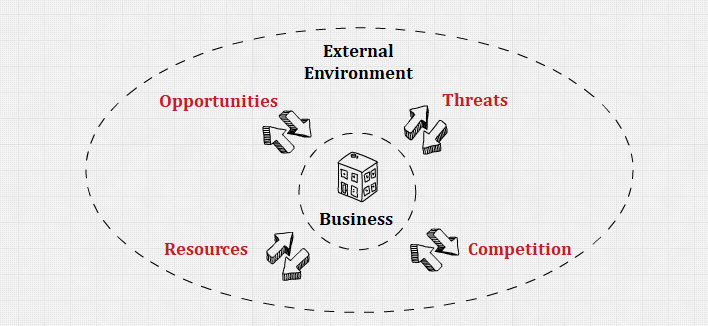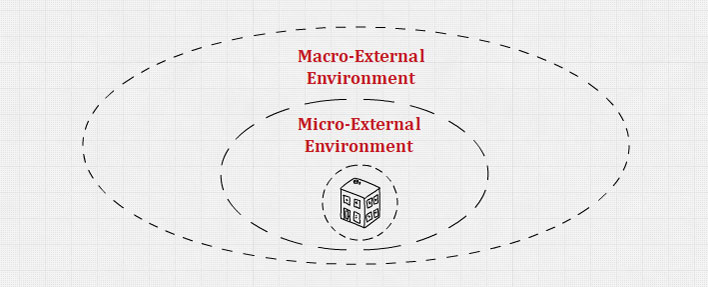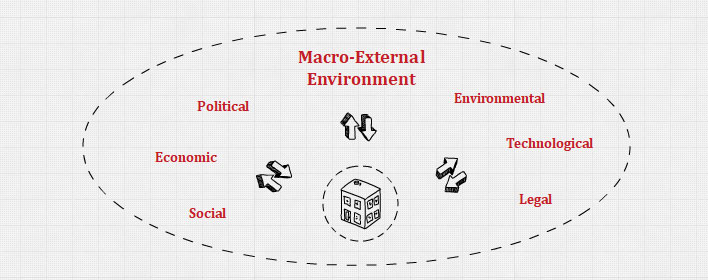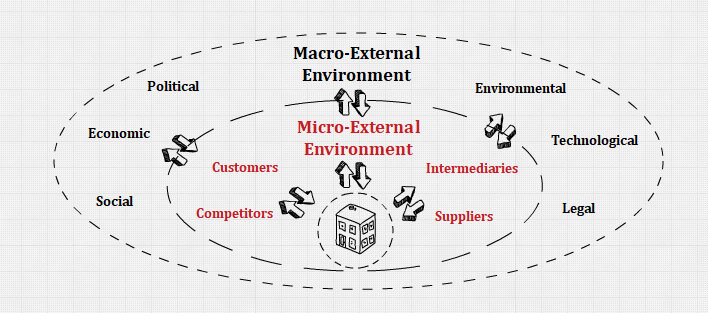What is the External Environment?

In strategy, the external environment comprises forces that exist outside the boundaries of an organization, but have potential and significant influence on its survival and growth.
Why Does the External Environment Matter?

There are 4 reasons why understanding the external environment that surrounds an organization is important to an organization.
First, the external environment provides resources that an organization needs in order to create goods and services.
As a human body must consume oxygen, food, and water, an organization needs to take in resources such as labor, money, and raw materials from outside its boundaries. An organization cannot survive without the support of its environment.
Second, the external environment is a source of opportunities and threats for an organization.
Opportunities are events and trends that create chances to improve an organization’s performance level. Threats are events and trends that may undermine an organization’s performance. Firms must realize that virtually any environmental trend or event is likely to create opportunities for some organizations and threats for others.
Third, the external environment shapes the various strategic decisions that executives make as they attempt to lead their organizations to success.
The environment often places important constraints on an organization’s objectives and strategies. External environment forces need to be taken into account when examining whether to start doing business in a new country, whether to acquire another company, and whether to launch an innovative product and so on.
Fourth, the external environment affects the competitive actions and responses firms take to outperform competitors and earn industry above-average returns.
The 2 Components of External Environment

The following 2 components of a firm’s external environment heavily influence its strategies: macro-environment (general environment), and micro-environment (industry environment).
An analysis of the macro-environment focuses on general trends, events, and their implications. An analysis of the micro-environment focuses on the industrial trends and events influencing an industry’s profitability potential.
In combination, the results of these 2 analyses influence the firm’s vision, mission, objectives, choice of strategies, and the competitive tactics it will take to implement those strategies.
Component 1: Macro-Environment (General Environment)

Define Macro-Environment and Its Forces
Macro-environment (general environment) is a major component of the external environment that produces general trends and events.
These trends and events in turn determine external strategic factors and classify opportunities for a firm to exploit for promoting its business and presents threats in the sense that they can put restrictions on the expansion of business activities.
In general, the macro-environment affects a firm’s objectives and strategies and influences its long-term decision-making.
Macro-environment composes of 6 forces (or dimensions) that influence an industry and the firms within it: (1) environmental, (2) demographic, (3) economic, (4) political/legal, (5) sociocultural, and (6) technological.
PEST technique analysis is the study to understand these forces. PEST technique is categorized into 4 areas: Political, Economic, Social, and Technological.
By including trends from the ecological forces, the combined technique can be called STEPE analysis, which stands for Political, Economic, Social, Technology, and Ecological environmental forces.
In some variations, other forces have been added to the techniques, such as legal and environmental. This type of scanning is one of the most widely used techniques in macro-environment analysis, which is called PESTLE, or PESTEL. It stands for Political, Economic, Social, Technological, Legal, and Environmental.
The characteristics of today’s macro-environment differ greatly from historical conditions.
Technological changes and the continuing growth of information gathering, and processing capabilities increase the need for firms to develop effective competitive tactics on a timely basis.
The rapid social changes occurring in many countries affect labor practices and the nature of products that increasingly diverse consumer’s demand.
Governmental policies and laws also affect where and how firms choose to compete.
Changes to several nations’ financial regulatory systems that have been enacted are expected to increase the complexity of organizations’ financial transactions.
Macro Force 1: Political-Legal Force
Political-legal force allocates power and provides constraints to organizations.
Trends and events may not only have a significant impact on the level of competition within an industry but also on which strategies can actually be successful. Political and legal factors, therefore, can represent key opportunities or threats for both small and large organizations.
Government bureaucracy can create multiple laws and regulations that make it impossible for an organization to operate profitably in some countries or industries. Many companies have altered or abandoned strategies because of political or legal actions.
Federal, state, local, and foreign governments are major regulators, deregulators, subsidizers, employers, and customers of organizations.
Macro Force 2: Economic Force
Economic force regulates the exchange of materials, money, and information.
Emerging trends in this force can have a significant impact on business activities. They have a direct impact on the potential attractiveness of various strategies.
Important components of economic force are GDP, interest rates, inflation rates, currency markets, and the global financial system.
Macro Force 3: Social Force
Social force regulates the values and customs of society.
Organizations that look into the future can find many different opportunities to offer products and services based on the social characteristics of the industries it is operating.
Significant trends of this force currently include (1) increasing environmental awareness, (2) growing health consciousness, (3) expanding seniors’ market, (4) declining mass market, (5) changing pace and location of life, (6) changing household composition, and (7) increasing diversity of the workforce.
Macro Force 4: Technological Force
Technological force generates problem-solving inventions.
Trends and events in technological force may cause a great impact on multiple industries.
Technological advancements can dramatically affect organizations’ products, services, markets, suppliers, distributors, competitors, customers, manufacturing processes, marketing practices, and competitive positions.
These advancements can generally create new competitive advantages that are more powerful than existing advantages. Firms should pursue strategies that take advantage of technological opportunities to achieve sustainable, competitive advantages in the marketplace.
Significant trends of this force include (1) portal information devices, (2) alternative energy sources, (3) virtual personal assistants, (4) genetically altered organisms, or (5) smart robots.
Macro Force 5: Environmental Force
Environmental force includes global resources, wildlife, and climate that are a part of existence on Earth.
The ability of an organization to pursue long-term sustainability is dependent not only upon the economic and social system that it operates directly within but also on the natural environment in which the organization is embedded.
The natural environment is often viewed as a free resource that is to be taken or fought over. Once they are controlled by a person or organization, it becomes an asset that can be sold, bought, or shared.
Trends in environmental force highly correlate to a firm’s performance. An organization must not only closely study the environmental force for possible strategic factors but also consider the impact of its activities upon the environment and include them in consideration for the strategic decision-making process.
Important Trends and Events are Strategic Factors
Each of the macro-environment’s forces nurtures trends and events that may or may not be relevant to the development of a particular firm. Trends and events in one force may be critical to a firm but not to others, or maybe important to firms in one industry, but not in other industries.
This particular phenomenon determines a firm’s strategic factors. These factors are trends and events that play an important role in determining a firm’s opportunities and threats, which in turn are critical to a firm’s objectives and strategies.
Firms must study these anticipated trends and events, and anticipate their effects on the firm’s ability to identify strategies. An adequate understanding of these strategic factors will allow a firm to remain successful as market conditions change.
Interrelationship between Macro-Environment and Firms
Decisions and actions of firms can affect forces in the macro-environment. Every action that an organization takes, such as raising its prices or launching an advertising campaign, creates some degree of change in the world around it.
Most organizations are limited to influencing their industry. A few organizations wield such power and influence that they can shape some elements of the general environment. Some aspects of the general environment, such as demographics, simply must be taken as a given by all organizations.
Overall, however, the macro-environment has a far greater influence on most organizations than they individually would ever have on the environment. Macro-environment also has a direct impact on forces of narrower environments resided within it, such as the micro-environment.
Component 2: Micro-Environment (Industry Environment)

Define Micro-Environment
The micro-environment (or industry environment, competitive environment) is a dynamic system of industries in which a firm competes.
Firms analyze and understand the micro-environment by acquiring information about competitors, customers, and other stakeholders to build their own base of knowledge and capabilities.
On basis of the new information, firms take actions, such as building new capabilities and core competencies, in hopes of buffering themselves from any threats and negative environmental effects and pursuing opportunities as the basis for better serving their stakeholders’ needs.
Industries Make Up Micro-Environment
An industry can be defined as a group of companies offering products or services that are close substitutes for each other.
The starting point of understanding the micro-environment is to identify the industries that a company competes. In order to identify these industries, executives must first take a customer-oriented view of their business, as opposed to a product-oriented view.
Substitutes of a product or services are other products or services that can be put in the same market. This market then serves the same basic customer needs.
If firms define industry boundaries incorrectly, they will miss other product offerings that may serve the same basic customer needs. Existing competitors and new entrants may then take advantage by developing and distributing these products and services.
Understand Competition within an Industry
Every organization that operates within an industry faces competition, whether small or big, national, multinational, or transnational.
A company’s closest competitors, its rivals, are those that serve the same basic customer needs. Organizations in the same industry environment collectively compete with one another by providing similar goods, services, or both. In the course of competition, these firms may influence one another.
Typically, companies use a rich mix of different competitive strategies to pursue above-average returns when competing in a particular industry. The industry’s structural characteristics will heavily influence these choices of strategies.
A competitive firm will start a price war if its rival firm in the industry is relatively small. If the rival firm is a big one that is capable of retaliating any adverse action from its rival, a competitive firm will hesitate to start a price war.
The benefits of competition are enjoyed by society and the markets in which the competing organizations operate. The customers get products and services of better quality at lower costs. They get a better value for their money because of competition.
A better understanding of the nature and extent of competition may be reached by answering the following questions: (1) Who are the competitors? (2) What are their product and services? (3) What are their market shares? (4) What are their financial positions? (5) What gives them cost and price advantages? (6) What are they likely to do next? (7) How strong is their distribution network? (8) What are their manpower strengths.
The nature of competition in an industry is more directly influenced by developments taking place in the micro-environment, than by forces from the macro-environment. Changes in the macro-environment affect resource availability, which in turn cause growth or decline of industries and firms operating within them.
The Forces of Micro-Environment
The 6 forces of micro-environment include (1) customers and consumers, (2) competitors, (3) market, (4) suppliers, (5) intermediaries, and (6) publics.
Forces in the micro-environment directly influence a firm through opportunities and threats. The way firms define their objectives, strategies, competitive actions, and responses are heavily dependent upon these micro forces.
The interactions among these forces determine an industry’s profitability potential. In turn, the industry’s profitability potential influences the choices each firm makes about its competitive actions and responses.
The strength of the forces may change over time as industry conditions change. The task facing firms is to recognize how changes in the forces give rise to new opportunities and threats and to formulate appropriate strategic responses.
The stronger each of these forces, the more limited the ability of established companies to raise prices and earn greater profits. A strong competitive force can be regarded as a threat because it depresses profits. A weak competitive force can be viewed as an opportunity because it allows a company to earn greater profits.
A force may not have the same effect on all firms in the industry. The challenge for a firm is to locate a position within an industry where it can favorably influence the forces or where it can successfully defend itself against their influence. The greater a firm’s capacity to favorably influence its industry environment, the greater the likelihood it will earn above-average returns.
Micro Force 1: Customers and Consumers
A customer purchases a firm’s product or service for a consumer who ultimately consumes or uses the product or service.
No organization can survive without customers and consumers. Since sales of a product or service are critical for a firm’s survival and growth, it is necessary to keep the customers satisfied. Taking care of customer’s sensitivity is essential for the success of a business firm.
A firm has to compete with rival firms to attract customers. In the modern-day of intense competition, firms have to either spend a lot on product advertisements or introduce new products and services to attract new sales while retaining the current customers.
Therefore, an organization must closely monitor and analyze the following: (1) Who are the customers/consumers? (2) What features or benefits are they looking for? (3) What are their income levels? (4) What are their tastes, preferences? and (5) What are their buying patterns, etc?
Micro Force 2: Competitors
Competitors of a firm are other business entities that compete with it for resources as well as markets.
Competition shapes business as firms compete with each other not only for the sale of their products but also in other areas of operations. Absolute monopolies in case of which competition is totally absent are found only in the sphere of what is called public utilities such as power distribution, telephone service, or gas distribution.
Under normal conditions, firms in an industry compete with each other for the sale of their products and services. This competition may be on the basis of the pricing. But there may be non-price competition under which firms engage through competitive advertising, sponsoring events such as cricket matches for sale of different varieties and models of their products, each claiming the superior nature of its products.
Not only is there a competition among the producers producing different varieties or brands of the same product, but also among firms producing diverse products as all products ultimately compete for attracting limited spending from the same consumer.
Complementors are companies or networks of companies that sell complementary goods or services that are compatible with the focal firm’s good or service. When a complementors’ good or service contributes to the functionality of a focal firm’s good or service, it, in turn, creates additional value for that firm. Analyzing complementors is important to understand a firm’s competitors.
A study of the competitive scenario (competitive analysis) is essential for marketers to identify opportunities and threats from competition. An organization must address the following questions: (1) Who are the competitors? (2) What are their present strategies and business objectives? and (3) Who are the most aggressive and powerful competitors?
Micro Force 3: Market
Market refers to the system of contact between an organization and its customers.
Firms should study trends and events that are the key success factors of the market: (1) The existing and the potential demand in the market, (2) Market growth rate, (3) Cost structure, (4) Price sensitivity, (5) Technological structure, and (6) Distribution system.
Micro Force 4: Suppliers
Suppliers refer to the providers of inputs, such as raw materials, equipment, and services to an organization.
Effective and efficient operations of a firm require a supply of inputs such as raw materials. If the supply of raw materials is uncertain, a firm will have to maintain a large stock of raw materials to continue its production process. This will unnecessarily raise its cost of production while reducing its profit margin.
To ensure a regular supply of inputs, some firms adopt a backward integration strategy and set up captive production plants for producing raw materials themselves. However, small firms usually cannot adopt this strategy of vertical integration and have to depend on outside sources for the supply of needed inputs.
Large companies have to deal with hundreds of suppliers to maintain their production.
Suppliers with their own bargaining power affect the working and cost structure of the industry. Therefore, it is important for an organization to carry out a study of the following: (1) Who are the suppliers? (2) What are their products, prices, and terms and conditions? and (3) Whether to outsource production or get it done in-house depending on this supplier environment, and so on.
Micro Force 5: Intermediaries
Intermediaries are agents and brokers who facilitate the contact between buyers and sellers to get a certain commission.
Distribution firms, wholesalers, or retailers play an essential role in selling and distributing the firm’s products and services to customers.
Intermediaries are also responsible for stocking and transporting goods from production site to destination, to the hand of customers. There are marketing service agencies such as marketing research firms, consulting firms, advertising agencies that assist firms in targeting, promoting, and selling their products and services to the right customers.
Connection with intermediaries is an important link between a firm and its customers. Intermediaries may exert a considerable influence on the business organizations as, in many cases, the consumers are not aware of the manufacturers and their products or services. Dislocation of this link will adversely affect the firm’s profits.
Micro Force 6: Publics
Publics is any group that has an actual or potential interest in or impact on a company’s ability to achieve its objectives.
Environmentalists, media groups, women’s associations, consumer protection groups, local groups, citizen associations are some important examples of publics that have an important bearing on the environment of the firms.
Resources
Further Reading
- Internal and External Environment Factors that Influences Organizational Decision Making (iedunote.com)
- External Environment (ceopedia.org)
- Definition of the Business environment, both Internal and External with their Components (the-definition.com)
- Business Environment: Meaning, Types, Why It Matters (penpoin.com)
- Macro Environment (vedantu.com)
- Main Components of Business Environment (businessmantalk.com)
Related Concepts
References
- Hitt, M. A., Ireland, D. R., & Hoskisson, R. E. (2019). Strategic Management: Concepts and Cases: Competitiveness and Globalization (MindTap Course List) (13th ed.). Cengage Learning.
- Hill, C. W. L., & Jones, G. R. (2011). Essentials of Strategic Management (Available Titles CourseMate) (3rd ed.). Cengage Learning.
- Mastering Strategic Management. (2016, January 18). Open Textbooks for Hong Kong.